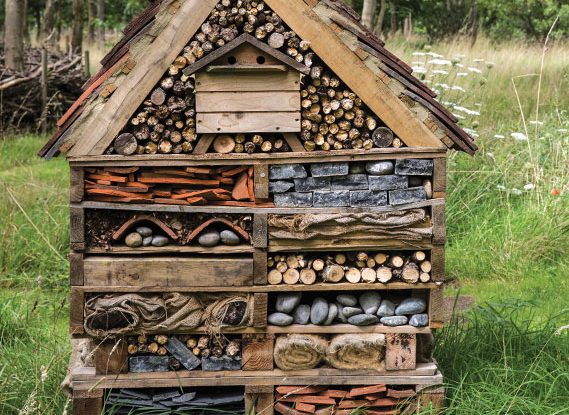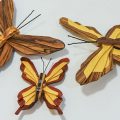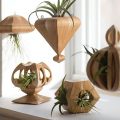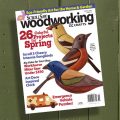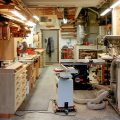Protect pollinators using common materials from around the yard and shop
By Kaylee Schofield
See the full article in our spring issue, coming soon!
Pollinating insects, such as bees, butterflies, and beetles, aren’t just pretty to look at—they’re vital to the life of our planet, acting as the “little gardeners” that keep plants and entire ecosystems healthy. Without pollinators, we’d have no champagne at weddings, no blueberries at breakfast, and no jack-o’-lanterns at Halloween—not to mention shrinking populations of backyard birds, for whom insects are a primary food source. And with Earth Day’s 50th anniversary (April 22, 2020) approaching, now is the perfect time to turn your backyard (or porch, or balcony) into a more pollinator-friendly space using easy-to-find materials from around the home and workshop. Note: While this is not a scrolling project, you can incorporate scrolling into your own insect condo design as desired.
Insect Condo Construction
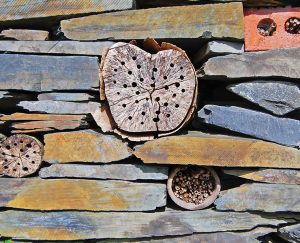
Nesting materials can be incorporated into existing structures like this stone fence.
“The goal of an insect condo is to create a healthy habitat for insects to live, reproduce, and pollinate,” said Kira Heeschen, Education Coordinator at the Earth Day Network. “Case in point, many native species of bees in the United States don’t actually form hives—they lay eggs in holes in trees, ground nests, and structures like insect condos.”
“Your garden space can become a great ecosystem,” added David Mizejewski, a naturalist with the National Wildlife Federation. “We know that insect condos work, even though this is based less on official scientific data and more on what I’d call ‘grassroots wisdom’!”
Insect condos vary in size and design but usually take the form of a square or rectangular frame made of wood planks or cinderblocks. That frame, stabilized by a sturdy back and roof, encompasses various nooks and crannies containing natural, nontoxic materials (see chart below)—each providing a safe haven for a different insect.
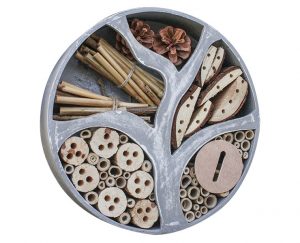
Scrolled or bandsawn designs can serve as creative armatures for insect condos.
And as David points out, the materials you choose for each section make a difference: “Make sure to source natural materials, such as firewood, locally to avoid spreading harmful pests like the spotted lanternfly or the emerald ash borer.” Avoid treated wood and synthetic materials, instead gathering leaves, hollowed-out plant stems, spruce cones, and scrap wood such as cedar and pine. If drilling holes into scrap wood, tailor the diameter of the holes to the size of the bees in your area. A backyard bamboo patch can be a useful resource, too; just cut the poles into lengths and drill cleanly through the tube walls to create little hollows where mason bees can lay their eggs.
Once your structure is built, place it in full sun, shielded from predators and facing south. Clean it periodically to head off decay, parasites, and mold growth, making sure not to disturb any friendly residents as you do so.
Materials to Use |
Materials to Avoid |
|
Twigs, natural cotton and other plant-based fabrics, scrap wood, pinecones, pine needles, lichen, leaves, shredded newspaper, straw, crushed rock, clay pots, cinderblocks |
Treated wood, plastic, anything containing paint or varnish, animal-based fabrics such as wool or leather, prepackaged/scented pinecones |
Pollinator-Friendly Plants
One key way to attract pollinators is to surround your insect condo with native perennial wildflowers. Where you live will determine which native plants are best, but for residents of North America, species like aster, beebalm, black-eyed Susan, columbine, evening primrose, goldenrod, lupine, milkweed, poppy, coneflower, St. John’s wort, sunflower, and violet are common. Before planting anything new, be sure to check the National Wildlife Federation’s Native Plant Finder (nwf.org/NativePlantFinder), which generates personalized lists of native plants based on your zip code. (We typed in our Mount Joy, Pa., location and got goldenrod and oak, among other things.)
Want to Get Involved?
If you choose to install native flowering perennials and/or an insect hotel around your living space, log your “act of green” on the Earth Day Network website, earthday.org. You can certify your new-and-improved insect habitat as a Garden for Wildlife with the National Wildlife Federation at nwf.org. These sites also offer educational tools and event information for those looking to take more steps to support pollinators and the environment.
Further Reading:
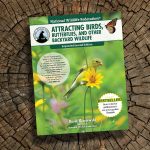
National Wildlife Federation: Attracting Birds, Butterflies, and Other Backyard Wildlife, Expanded Second Edition
By David Mizejewski
Item 8187. Available for $19.99 + S&H (parcel post) from Fox Chapel Publishing, 800-457-9112, FoxChapelPublishing.com.
 |
• Get the current issue! Purchase the Issue• For more articles like this, subscribe to Scroll Saw Woodworking & Crafts magazine. • Plus! Get digital mini magazines in your e-mail between printed issues. Subscribe to our free e-newsletter, Short Cuts.
|


